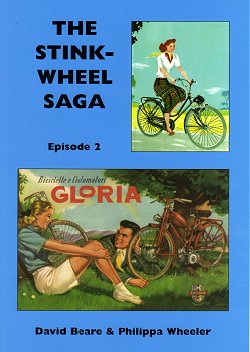 Go
to the Archive index
Go
to the Archive index
It is over four years since Episode 1 of the Stinkwheel Saga hit the bookshelves. Episode 2 has been a long time coming but now, at last, it's here. As is the case with many sequels, it is a slight disappointment and does not quite match up to its predecessor. However, let us get one thing straight, this is a good book. It is the best you will find on the subject. It has only one major fault and just a few minor ones.
Episode 1 covered the most popular cyclemotors of the 1950s: Cyclemaster, Mini-Motor, Winged Wheel, Power Pak, Cucciolo, Firefly, Cyclaid, GYS/Cairns and Mosquito. Episode 2 completes the Saga by mopping up the rest - the also-rans. With any review of cyclemotors, the main problem is where to draw the line: where do cyclemotors end and mopeds start? The VéloSoleX forms a useful border line and Stinkwheel seems to have adopted this. Included in the book are Cymota, Berini, Teagle, Lohmann, VAP, Tailwind, Busy Bee, Itom, TI Powerwheel, Ostler, ABJ, Bantamoto and Bikotor. There are a couple of extras in the form of the war-time Bugatti and Geoff Hudspith's more recent Steam Bicycle. But where is the Phillips? The Phillips Motorised Bicycle was a 1950s cyclemotor put into production by one of the UK's biggest cycle makers - yet it is nowhere to be found in this book. Admittedly, it was only sold as a 'built-in' rather than a 'clip-on', but both its frame (the Phillips P36) and engine (the Rex) were marketed separately. The Phillips was more of a true cyclemotor than the ABJ, which does appear in this book. To forget it surely counts as a major omission.
As in Episode 1, the machines are described in great detail with a wealth of period illustrations. The entertaining writing style of the first volume also carries over to the new book. The authors have dug up a huge amount of information about their subjects and, in several cases, there is much material that has not been published anywhere else before.
Any reader who cares about good English will probably find the book a little irritating. In particular, the punctuation is very wayward at times. Another minor irritation is the way that many picture captions are indistinguishable from the main body of the text. However, these are minor points that should not detract from the wealth of information presented in this book.
Anyone interested in cyclemotors will almost certainly already have a copy of The Stinkwheel Saga, Episode 1. That book set high standards that Episode 2 does not quite manage to live up to. Nevertheless, this is a well-researched, comprehensive look at the cyclemotors of the 1950s. It is a 'must have' for any cyclemotor enthusiast ... unless, perhaps, your particular enthusiasm is for the Phillips Motorised Bicycle.
November 2008